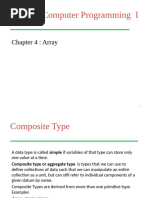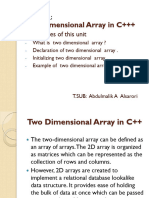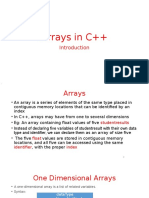0 ratings0% found this document useful (0 votes)
5 viewsintrd to array
Uploaded by
e716580009Copyright
© © All Rights Reserved
We take content rights seriously. If you suspect this is your content, claim it here.
Available Formats
Download as PDF, TXT or read online on Scribd
0 ratings0% found this document useful (0 votes)
5 viewsintrd to array
Uploaded by
e716580009Copyright
© © All Rights Reserved
We take content rights seriously. If you suspect this is your content, claim it here.
Available Formats
Download as PDF, TXT or read online on Scribd
You are on page 1/ 11
UNIT1 :
Introduction to Array
Adjectives of this unit
- What Is Array ?
- Advantage And Disadvantage Of Array .
- Types Of Array .
- Declaration Of Array .
- Example Of Array.
T.SUB: Abdulmalik A Alsarori
What Is Array
It is a collection of fixed number of elements
,wherein all of elements have the same data
type.
It is used to store multiple values in a single
variable.
Note:
- Consecutive group of memory locations that
all have the same type.
- The collection of data is indexed or
numbered, and at starts at 0 and the highest
element index is one less than total number
of elements in the array.
Advantage and disadvantage of array
Advantage of array :
- use of less line of code.
- easy access to all the elements.
- traversal through the array.
- sorting becomes easy.
disadvantage of array :
- allows a fixed number of elements.
Type of array
One dimensional array .
Two dimensional array.
Multidimensional array.
One dimensional array “ single array”
In this type of array, it stores elements in
a single dimension. And, In this array, a
single specification is required to describe
elements of the array.
Declaration of One Dimensional Array
To declare an array in C++, you need to
define
- The data type of elements in the array
- The name of the array
- The size of the array
Syntax:
Data_type Array_Name [size];
Note :
size of array is any positive integer or
constant variable.
Example
For Example:
define SIZE =7
int score[SIZE];
Suppose, we have array int score[7] as shown in below
figure:
Initializing One Dimensional Array
we can initialize one-dimensional array at compile
time and at run time.
Compile Time Initialization:
Arrays can be initialized at the time they are declared.
This is also known as compile-time initialization.
- int std[5]= {1,2,3,4,5}
1 2 3 4 5
std0 std1 std2 std 3 std4
- int std[]= {1,2,3,4,5}
1 2 3 4 5
std0 std1 std 2 std3 std4
Initializing One Dimensional Array
- int std [5]= {0}
0 0 0 0 0
std0 std1 std2 std3 std4
- int std[5]={1,2}
1 2 0 0 0
std0 std1 std2 std3 std4
Initializing One Dimensional Array
Run Time Initialization:
An array can be explicitly initialized at run
time. This approach is usually applied for
initializing large arrays.
example: int std[5];
for(int i=0, i<=4 ,i++)
cout<<“enter the element of array”<<i,
cin>> std[i];
Examples out put
#include<stream.h>
void main() {
int arr[5];
for(i = 0; i < 5; i++)
{
cout <<"Enter a[“ << i <<"]:", i);
cin>>arr[i];
}
You might also like
- Intrd To Array + Single Array T.abduLMALIKNo ratings yetIntrd To Array + Single Array T.abduLMALIK11 pages
- Cs112 - Programming Fundamental: Lecture # 27 - Arrays in C Syed Shahrooz ShamimNo ratings yetCs112 - Programming Fundamental: Lecture # 27 - Arrays in C Syed Shahrooz Shamim14 pages
- Introduction To Computer Programming ProgrammingNo ratings yetIntroduction To Computer Programming Programming54 pages
- Introduction To Arrays To File Handling (C)No ratings yetIntroduction To Arrays To File Handling (C)58 pages
- DFC20113 - Programming Fundamentals: Understand The Use of ArrayNo ratings yetDFC20113 - Programming Fundamentals: Understand The Use of Array58 pages
- C++ Chapter 4 Array, String and PointerNo ratings yetC++ Chapter 4 Array, String and Pointer42 pages
- ARRAY in C++: Kristina Jonas E. MendozaNo ratings yetARRAY in C++: Kristina Jonas E. Mendoza11 pages
- 1D, 2D and Multi-Dimensional Arrays - ComputerSC PDFNo ratings yet1D, 2D and Multi-Dimensional Arrays - ComputerSC PDF49 pages
- Fundamentals of Computer Programming: Arrays (CLO3)No ratings yetFundamentals of Computer Programming: Arrays (CLO3)17 pages
- An Array Is A Collection of Data Elements ofNo ratings yetAn Array Is A Collection of Data Elements of51 pages
- Smart Card Research and Advanced Applications 13th International ConferenceNo ratings yetSmart Card Research and Advanced Applications 13th International Conference261 pages
- (Ebook) AWS System Administration, 2nd Edition (Second Early Release) by Mike Ryan and Federico Lucifredi ISBN 9781492081562, 1492081566 - The full ebook version is ready for instant download100% (2)(Ebook) AWS System Administration, 2nd Edition (Second Early Release) by Mike Ryan and Federico Lucifredi ISBN 9781492081562, 1492081566 - The full ebook version is ready for instant download77 pages
- Nov 21 P2 V3-Cs-qqqqqqqqqqqqqqqqqqqqqqqqqqqNo ratings yetNov 21 P2 V3-Cs-qqqqqqqqqqqqqqqqqqqqqqqqqqq10 pages
- Module II: Programming in C: Amity School of Engineering and TechnologyNo ratings yetModule II: Programming in C: Amity School of Engineering and Technology100 pages
- Informatics Practices: Class XI (As Per CBSE Board)No ratings yetInformatics Practices: Class XI (As Per CBSE Board)23 pages
- Database Lab Assignment 1: Study of M SQL & OracleNo ratings yetDatabase Lab Assignment 1: Study of M SQL & Oracle22 pages
- Caie As Computer Science 9618 Practical v3No ratings yetCaie As Computer Science 9618 Practical v39 pages

























































































